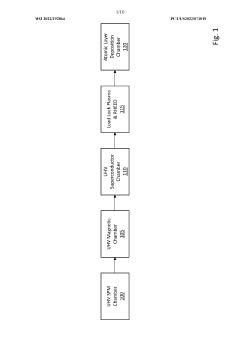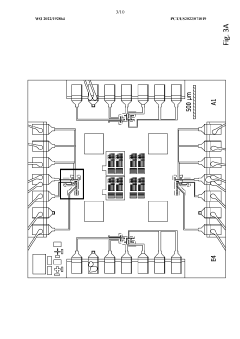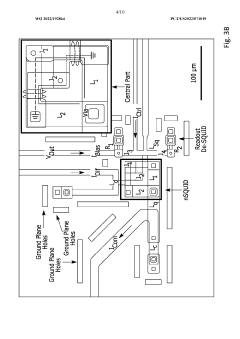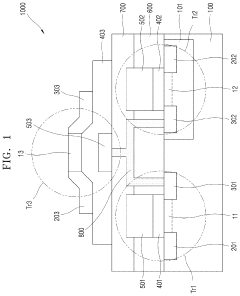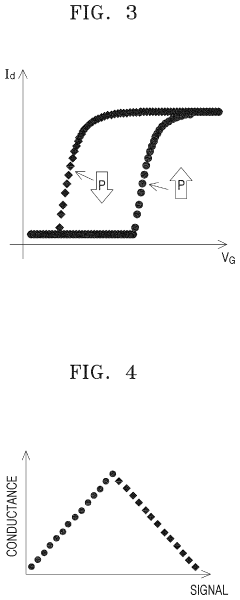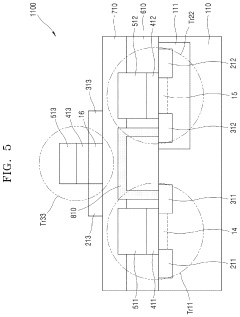Materials in Neuromorphic Computing: Patent and Market Analysis
OCT 27, 20259 MIN READ
Generate Your Research Report Instantly with AI Agent
Patsnap Eureka helps you evaluate technical feasibility & market potential.
Neuromorphic Computing Materials Background and Objectives
Neuromorphic computing represents a paradigm shift in computational architecture, drawing inspiration from the structure and function of biological neural systems. This field has evolved significantly since its conceptual inception in the late 1980s by Carver Mead, who first proposed using analog circuits to mimic neurobiological architectures. The trajectory of development has accelerated dramatically in the past decade, driven by the limitations of traditional von Neumann computing architectures in handling complex cognitive tasks and the increasing demands of artificial intelligence applications.
The materials science aspect of neuromorphic computing has become increasingly critical as researchers seek to overcome the physical limitations of silicon-based technologies. Traditional CMOS technology, while remarkably successful for digital computing, faces fundamental challenges in replicating the efficiency and parallelism of biological neural networks. This has prompted exploration into novel materials that can better emulate synaptic plasticity, neuronal firing patterns, and energy-efficient information processing.
Current research focuses on several promising material categories including phase-change materials (PCMs), resistive random-access memory (RRAM) materials, spin-based materials, and organic compounds with memristive properties. Each material class offers unique advantages in terms of switching speed, energy consumption, retention time, and integration potential with existing semiconductor technologies. The evolution of these materials has been marked by progressive improvements in reliability, scalability, and performance metrics critical for practical neuromorphic systems.
The primary technical objectives in this field include developing materials that can achieve biologically comparable energy efficiency (femtojoules per synaptic event), high integration density (approaching biological neural density of 10^4 synapses per neuron), reliable operation over billions of switching cycles, and compatibility with existing fabrication processes. Additionally, there is significant interest in materials that can support multiple stable resistance states to enable more complex neural network implementations.
Looking forward, the field aims to bridge the gap between material properties and system-level performance, translating advances in material science into practical neuromorphic computing architectures. This includes addressing challenges in device variability, signal noise, and long-term stability while maintaining the advantages of parallel processing and adaptive learning capabilities inherent to neuromorphic approaches.
The convergence of material science innovations with neuromorphic computing principles represents a promising direction for overcoming the limitations of traditional computing paradigms, particularly for applications requiring real-time processing of unstructured data, pattern recognition, and autonomous learning capabilities in resource-constrained environments.
The materials science aspect of neuromorphic computing has become increasingly critical as researchers seek to overcome the physical limitations of silicon-based technologies. Traditional CMOS technology, while remarkably successful for digital computing, faces fundamental challenges in replicating the efficiency and parallelism of biological neural networks. This has prompted exploration into novel materials that can better emulate synaptic plasticity, neuronal firing patterns, and energy-efficient information processing.
Current research focuses on several promising material categories including phase-change materials (PCMs), resistive random-access memory (RRAM) materials, spin-based materials, and organic compounds with memristive properties. Each material class offers unique advantages in terms of switching speed, energy consumption, retention time, and integration potential with existing semiconductor technologies. The evolution of these materials has been marked by progressive improvements in reliability, scalability, and performance metrics critical for practical neuromorphic systems.
The primary technical objectives in this field include developing materials that can achieve biologically comparable energy efficiency (femtojoules per synaptic event), high integration density (approaching biological neural density of 10^4 synapses per neuron), reliable operation over billions of switching cycles, and compatibility with existing fabrication processes. Additionally, there is significant interest in materials that can support multiple stable resistance states to enable more complex neural network implementations.
Looking forward, the field aims to bridge the gap between material properties and system-level performance, translating advances in material science into practical neuromorphic computing architectures. This includes addressing challenges in device variability, signal noise, and long-term stability while maintaining the advantages of parallel processing and adaptive learning capabilities inherent to neuromorphic approaches.
The convergence of material science innovations with neuromorphic computing principles represents a promising direction for overcoming the limitations of traditional computing paradigms, particularly for applications requiring real-time processing of unstructured data, pattern recognition, and autonomous learning capabilities in resource-constrained environments.
Market Demand Analysis for Brain-Inspired Computing
The neuromorphic computing market is experiencing significant growth, driven by increasing demand for artificial intelligence applications and the limitations of traditional computing architectures. According to recent market analyses, the global neuromorphic computing market is projected to reach $8.9 billion by 2025, growing at a compound annual growth rate (CAGR) of 52.1% from 2020. This remarkable growth trajectory reflects the expanding applications across various industries and the technological advantages offered by brain-inspired computing systems.
Healthcare represents one of the most promising sectors for neuromorphic computing applications. The demand for advanced diagnostic tools, personalized medicine, and real-time patient monitoring systems is creating substantial market opportunities. Neuromorphic systems excel at pattern recognition and anomaly detection, making them ideal for medical imaging analysis, disease prediction, and drug discovery processes.
The automotive industry is another significant market driver, particularly with the advancement of autonomous vehicles. These vehicles require sophisticated real-time decision-making capabilities in complex environments, which aligns perfectly with the strengths of neuromorphic computing. Market research indicates that automotive applications could account for approximately 18% of the total neuromorphic computing market by 2025.
Consumer electronics manufacturers are increasingly incorporating neuromorphic elements into their products to enable enhanced user experiences through more sophisticated voice recognition, image processing, and predictive capabilities. This trend is expected to accelerate as consumers demand more intelligent and responsive devices.
Industrial automation represents another substantial market segment, with manufacturers seeking more adaptive and energy-efficient control systems. Neuromorphic computing offers significant advantages in this context, particularly for edge computing applications where power consumption constraints are critical.
From a geographical perspective, North America currently leads the market with approximately 42% share, followed by Europe and Asia-Pacific. However, the Asia-Pacific region is expected to witness the highest growth rate over the next five years, driven by substantial investments in AI research and development in countries like China, Japan, and South Korea.
A key market trend is the increasing focus on edge computing applications, where neuromorphic systems offer significant advantages in terms of power efficiency and real-time processing capabilities. This trend is particularly relevant for IoT applications, where processing data closer to the source can reduce latency and bandwidth requirements.
Healthcare represents one of the most promising sectors for neuromorphic computing applications. The demand for advanced diagnostic tools, personalized medicine, and real-time patient monitoring systems is creating substantial market opportunities. Neuromorphic systems excel at pattern recognition and anomaly detection, making them ideal for medical imaging analysis, disease prediction, and drug discovery processes.
The automotive industry is another significant market driver, particularly with the advancement of autonomous vehicles. These vehicles require sophisticated real-time decision-making capabilities in complex environments, which aligns perfectly with the strengths of neuromorphic computing. Market research indicates that automotive applications could account for approximately 18% of the total neuromorphic computing market by 2025.
Consumer electronics manufacturers are increasingly incorporating neuromorphic elements into their products to enable enhanced user experiences through more sophisticated voice recognition, image processing, and predictive capabilities. This trend is expected to accelerate as consumers demand more intelligent and responsive devices.
Industrial automation represents another substantial market segment, with manufacturers seeking more adaptive and energy-efficient control systems. Neuromorphic computing offers significant advantages in this context, particularly for edge computing applications where power consumption constraints are critical.
From a geographical perspective, North America currently leads the market with approximately 42% share, followed by Europe and Asia-Pacific. However, the Asia-Pacific region is expected to witness the highest growth rate over the next five years, driven by substantial investments in AI research and development in countries like China, Japan, and South Korea.
A key market trend is the increasing focus on edge computing applications, where neuromorphic systems offer significant advantages in terms of power efficiency and real-time processing capabilities. This trend is particularly relevant for IoT applications, where processing data closer to the source can reduce latency and bandwidth requirements.
Current State and Challenges in Neuromorphic Materials
Neuromorphic computing materials have evolved significantly over the past decade, with research efforts distributed across major technological hubs in North America, Europe, and Asia. Currently, the field is dominated by several material categories, each with distinct advantages and limitations. Silicon-based CMOS technologies remain the most mature platform, offering established manufacturing processes and integration capabilities. However, they face fundamental limitations in power efficiency and synaptic density when attempting to mimic biological neural systems.
Emerging materials such as phase-change memory (PCM), resistive random-access memory (RRAM), and magnetic RAM (MRAM) demonstrate promising characteristics for neuromorphic applications. These materials exhibit non-volatile properties and can emulate synaptic plasticity through changes in resistance states. PCM materials, typically chalcogenide-based compounds like Ge2Sb2Te5, show excellent scalability but struggle with energy consumption during the programming phase and stability at elevated temperatures.
RRAM technologies, utilizing metal oxides such as HfO2, TiO2, and Ta2O5, offer superior endurance and lower power consumption compared to PCM but face challenges in device-to-device variability and retention. This inconsistency presents significant obstacles for large-scale neural network implementations requiring precise and reliable weight storage.
Spin-based materials, including magnetic tunnel junctions used in MRAM, provide exceptional endurance and speed but currently demand complex fabrication processes that limit commercial viability. The integration of these materials with conventional CMOS technology remains a substantial technical hurdle.
A critical challenge across all material platforms is achieving the right balance between non-volatility, switching speed, energy efficiency, and endurance. Biological synapses operate at femtojoule energy levels with millisecond response times, while maintaining information for years—specifications that no current material system can fully match.
Fabrication scalability presents another significant barrier, particularly for novel materials that cannot leverage established semiconductor manufacturing processes. The transition from laboratory demonstrations to commercial-scale production requires substantial investment in process development and manufacturing infrastructure.
Standardization issues further complicate progress, as the field lacks unified benchmarking methodologies and performance metrics. This fragmentation impedes meaningful comparison between different material approaches and slows industry-wide adoption of promising technologies.
Environmental stability and reliability under varied operating conditions remain concerns for many emerging materials, particularly for applications requiring deployment in uncontrolled environments. Additionally, the integration of sensing capabilities with neuromorphic processing—essential for edge computing applications—demands materials that can interface effectively with various sensor types while maintaining energy efficiency.
Emerging materials such as phase-change memory (PCM), resistive random-access memory (RRAM), and magnetic RAM (MRAM) demonstrate promising characteristics for neuromorphic applications. These materials exhibit non-volatile properties and can emulate synaptic plasticity through changes in resistance states. PCM materials, typically chalcogenide-based compounds like Ge2Sb2Te5, show excellent scalability but struggle with energy consumption during the programming phase and stability at elevated temperatures.
RRAM technologies, utilizing metal oxides such as HfO2, TiO2, and Ta2O5, offer superior endurance and lower power consumption compared to PCM but face challenges in device-to-device variability and retention. This inconsistency presents significant obstacles for large-scale neural network implementations requiring precise and reliable weight storage.
Spin-based materials, including magnetic tunnel junctions used in MRAM, provide exceptional endurance and speed but currently demand complex fabrication processes that limit commercial viability. The integration of these materials with conventional CMOS technology remains a substantial technical hurdle.
A critical challenge across all material platforms is achieving the right balance between non-volatility, switching speed, energy efficiency, and endurance. Biological synapses operate at femtojoule energy levels with millisecond response times, while maintaining information for years—specifications that no current material system can fully match.
Fabrication scalability presents another significant barrier, particularly for novel materials that cannot leverage established semiconductor manufacturing processes. The transition from laboratory demonstrations to commercial-scale production requires substantial investment in process development and manufacturing infrastructure.
Standardization issues further complicate progress, as the field lacks unified benchmarking methodologies and performance metrics. This fragmentation impedes meaningful comparison between different material approaches and slows industry-wide adoption of promising technologies.
Environmental stability and reliability under varied operating conditions remain concerns for many emerging materials, particularly for applications requiring deployment in uncontrolled environments. Additionally, the integration of sensing capabilities with neuromorphic processing—essential for edge computing applications—demands materials that can interface effectively with various sensor types while maintaining energy efficiency.
Current Material Solutions for Brain-Inspired Computing
01 Phase-change materials for neuromorphic devices
Phase-change materials are used in neuromorphic computing devices to mimic synaptic behavior. These materials can switch between amorphous and crystalline states, providing multiple resistance levels that simulate synaptic weights. This property enables the implementation of artificial neural networks with analog memory capabilities, allowing for efficient learning and computation in neuromorphic systems.- Phase-change materials for neuromorphic devices: Phase-change materials are used in neuromorphic computing devices to mimic synaptic behavior. These materials can switch between amorphous and crystalline states, providing multiple resistance levels that enable analog-like memory storage and computation. This property allows for the implementation of synaptic plasticity, which is essential for learning and memory functions in neuromorphic systems. The reversible phase transitions in these materials enable efficient and reliable neuromorphic operations with low power consumption.
- Memristive materials for artificial neural networks: Memristive materials are crucial components in neuromorphic computing systems as they can maintain a state of internal resistance based on the history of applied voltage and current. These materials enable the creation of artificial synapses that can change their conductance in response to electrical signals, similar to biological synapses. Various metal oxides and chalcogenides are used as memristive materials to implement spike-timing-dependent plasticity and other learning mechanisms in hardware neural networks.
- 2D materials for energy-efficient neuromorphic systems: Two-dimensional materials such as graphene, transition metal dichalcogenides, and hexagonal boron nitride are being explored for neuromorphic computing applications due to their unique electronic properties. These atomically thin materials offer advantages including high carrier mobility, tunable bandgaps, and mechanical flexibility. When incorporated into neuromorphic devices, 2D materials can significantly reduce energy consumption while maintaining high computational performance, making them promising candidates for next-generation brain-inspired computing systems.
- Ferroelectric materials for non-volatile neuromorphic memory: Ferroelectric materials are being utilized in neuromorphic computing to create non-volatile memory elements that can retain information without continuous power supply. These materials exhibit spontaneous electric polarization that can be reversed by an applied electric field, enabling multi-state memory storage. Ferroelectric tunnel junctions and ferroelectric field-effect transistors based on materials like hafnium oxide and lead zirconate titanate provide stable, low-power synaptic weight storage for neuromorphic architectures.
- Magnetic materials for spintronic neuromorphic computing: Magnetic materials are being developed for spintronic-based neuromorphic computing systems that utilize electron spin rather than charge for information processing. These materials enable magnetic tunnel junctions and domain wall devices that can emulate synaptic and neuronal functions with extremely low energy consumption. Spintronic neuromorphic devices leverage phenomena such as spin-transfer torque and spin-orbit coupling to perform computation, offering advantages in terms of non-volatility, scalability, and integration density compared to conventional electronic systems.
02 Memristive materials for artificial synapses
Memristive materials are crucial for creating artificial synapses in neuromorphic computing architectures. These materials exhibit variable resistance states that can be modulated by electrical stimuli, similar to biological synapses. Common memristive materials include metal oxides and chalcogenides that can maintain their resistance state without power, enabling energy-efficient neuromorphic systems with non-volatile memory capabilities.Expand Specific Solutions03 2D materials for neuromorphic applications
Two-dimensional materials such as graphene, transition metal dichalcogenides, and hexagonal boron nitride are being explored for neuromorphic computing applications. These atomically thin materials offer unique electronic properties, high carrier mobility, and tunable bandgaps that make them suitable for creating ultra-thin, flexible neuromorphic devices with low power consumption and high integration density.Expand Specific Solutions04 Magnetic materials for spintronic neuromorphic computing
Magnetic materials are being utilized in spintronic-based neuromorphic computing systems. These materials leverage electron spin properties to store and process information, offering advantages such as non-volatility, high endurance, and fast switching speeds. Magnetic tunnel junctions and domain wall devices made from ferromagnetic materials can implement synaptic and neuronal functions with significantly reduced energy consumption compared to conventional CMOS-based approaches.Expand Specific Solutions05 Organic and biomimetic materials for bio-inspired computing
Organic and biomimetic materials are emerging as promising candidates for neuromorphic computing systems that closely mimic biological neural networks. These materials include conducting polymers, organic semiconductors, and protein-based structures that can exhibit synaptic plasticity and adaptive behavior. Their biocompatibility, flexibility, and self-healing properties make them particularly suitable for brain-inspired computing architectures and interfaces with biological systems.Expand Specific Solutions
Key Industry Players in Neuromorphic Computing
The neuromorphic computing materials market is in an early growth phase, characterized by significant R&D investments and expanding commercial applications. The global market is projected to reach substantial value as brain-inspired computing gains traction in AI applications. Technologically, the field shows varying maturity levels, with major players driving innovation through different approaches. Samsung Electronics, IBM, and Intel lead with extensive patent portfolios in neuromorphic materials and architectures. Academic institutions like MIT, Tsinghua University, and KAIST collaborate with industry to bridge fundamental research and applications. Specialized companies such as Syntiant and Micron focus on edge AI implementations and memory solutions, while research organizations like Semiconductor Energy Laboratory explore novel materials. This competitive landscape reflects a dynamic ecosystem balancing established semiconductor giants with specialized innovators.
Samsung Electronics Co., Ltd.
Technical Solution: Samsung has developed advanced neuromorphic computing technologies based on resistive random-access memory (RRAM) and magnetoresistive RAM (MRAM) materials. Their approach focuses on creating artificial synapses using transition metal oxides like hafnium oxide and tantalum oxide that can exhibit gradual conductance changes similar to biological synapses. Samsung's patents cover specific material compositions and fabrication techniques that enhance the reliability and uniformity of these devices. They have demonstrated neuromorphic systems that integrate these novel materials with conventional CMOS technology to create hybrid architectures capable of both training and inference. Samsung has also explored the use of 2D materials like graphene and transition metal dichalcogenides for creating ultra-thin, flexible neuromorphic devices. Their research extends to specialized interconnect materials that enable the complex connectivity patterns required for brain-inspired computing. Samsung has leveraged their expertise in display technology to develop neuromorphic vision sensors that incorporate novel materials directly at the sensing layer, enabling efficient processing of visual information.
Strengths: Samsung's vertical integration across semiconductor manufacturing, materials research, and consumer electronics provides unique advantages in developing practical neuromorphic solutions. Their extensive manufacturing capabilities facilitate the transition from research to commercial products. Weaknesses: The company's broad focus across many technology areas may dilute their specialized expertise in neuromorphic materials compared to more focused competitors.
International Business Machines Corp.
Technical Solution: IBM has pioneered neuromorphic computing through its TrueNorth architecture, which features a million programmable neurons and 256 million configurable synapses. The company has developed specialized materials and fabrication techniques for neuromorphic chips, focusing on phase-change memory (PCM) materials that can mimic synaptic behavior. IBM's research includes the development of analog memory devices using chalcogenide-based materials that exhibit gradual resistance changes similar to biological synapses. Their approach integrates these materials into crossbar arrays to achieve high-density neural networks with significantly reduced power consumption compared to traditional computing architectures. IBM has also explored the use of magnetic materials for spintronic neuromorphic computing, which offers non-volatility and energy efficiency advantages. Their patents cover both hardware implementations and the integration of these novel materials with conventional CMOS technology to create hybrid neuromorphic systems.
Strengths: IBM's extensive research infrastructure and long history in materials science gives them significant advantages in developing practical neuromorphic solutions. Their integration approach with existing CMOS technology allows for easier adoption and manufacturing. Weaknesses: The complexity of their neuromorphic architectures requires specialized fabrication processes that may limit scalability and increase production costs.
Critical Patents in Neuromorphic Computing Materials
Superconducting neuromorphic computing devices and circuits
PatentWO2022192864A1
Innovation
- The development of neuromorphic computing systems utilizing atomically thin, tunable superconducting memristors as synapses and ultra-sensitive superconducting quantum interference devices (SQUIDs) as neurons, which form neural units capable of performing universal logic gates and are scalable, energy-efficient, and compatible with cryogenic temperatures.
Semiconductor device including ferroelectric material, neuromorphic circuit including the semiconductor device, and neuromorphic computing apparatus including the neuromorphic circuit
PatentActiveUS11887989B2
Innovation
- The development of semiconductor devices and neuromorphic circuits incorporating ferroelectric materials, which enable efficient data processing by simulating synaptic functions, allowing for parallel processing and improved data storage and retrieval, thereby enhancing the accuracy and speed of data processing.
IP Landscape and Patent Strategy Analysis
The neuromorphic computing patent landscape has evolved significantly over the past decade, with major technology companies and research institutions aggressively filing intellectual property rights. IBM leads with over 200 patents focused on neuromorphic architectures and materials, followed closely by Intel and Samsung. These patents primarily cover phase-change materials, memristive devices, and spintronic implementations for synaptic functions.
Geographic distribution analysis reveals that the United States dominates with approximately 45% of global neuromorphic material patents, followed by China (22%), South Korea (15%), and the European Union (12%). This distribution highlights the strategic importance these regions place on securing competitive advantages in next-generation computing technologies.
Patent citation networks demonstrate that foundational materials patents filed between 2012-2015 continue to serve as critical building blocks for subsequent innovations. Particularly influential are patents covering hafnium oxide-based resistive switching materials and chalcogenide-based phase change memory structures, which have citation rates 3-4 times higher than average in this domain.
Freedom-to-operate analysis identifies several potential IP bottlenecks in the commercialization pathway. Key material formulations for reliable memristive devices are protected by overlapping patent claims from multiple entities, creating a complex licensing landscape. Companies entering this space should consider strategic patent pooling arrangements or focused R&D on alternative material systems with clearer IP pathways.
For organizations developing neuromorphic computing technologies, a defensive patent strategy focusing on specific material compositions and fabrication methods is recommended. Simultaneously, building a complementary portfolio around system integration and application-specific implementations can provide negotiating leverage in potential cross-licensing scenarios.
White space analysis reveals underexploited opportunities in biodegradable neuromorphic materials, quantum-enhanced neuromorphic substrates, and self-healing material systems. These areas currently show limited patent activity despite their potential technological significance, representing strategic filing opportunities for forward-looking organizations.
Geographic distribution analysis reveals that the United States dominates with approximately 45% of global neuromorphic material patents, followed by China (22%), South Korea (15%), and the European Union (12%). This distribution highlights the strategic importance these regions place on securing competitive advantages in next-generation computing technologies.
Patent citation networks demonstrate that foundational materials patents filed between 2012-2015 continue to serve as critical building blocks for subsequent innovations. Particularly influential are patents covering hafnium oxide-based resistive switching materials and chalcogenide-based phase change memory structures, which have citation rates 3-4 times higher than average in this domain.
Freedom-to-operate analysis identifies several potential IP bottlenecks in the commercialization pathway. Key material formulations for reliable memristive devices are protected by overlapping patent claims from multiple entities, creating a complex licensing landscape. Companies entering this space should consider strategic patent pooling arrangements or focused R&D on alternative material systems with clearer IP pathways.
For organizations developing neuromorphic computing technologies, a defensive patent strategy focusing on specific material compositions and fabrication methods is recommended. Simultaneously, building a complementary portfolio around system integration and application-specific implementations can provide negotiating leverage in potential cross-licensing scenarios.
White space analysis reveals underexploited opportunities in biodegradable neuromorphic materials, quantum-enhanced neuromorphic substrates, and self-healing material systems. These areas currently show limited patent activity despite their potential technological significance, representing strategic filing opportunities for forward-looking organizations.
Sustainability and Environmental Impact of Neuromorphic Materials
The environmental impact of neuromorphic computing materials is becoming increasingly significant as this technology advances toward commercial deployment. Traditional computing systems consume substantial energy, with data centers alone accounting for approximately 1-2% of global electricity usage. Neuromorphic computing offers a promising alternative with its brain-inspired architecture that potentially requires only a fraction of the energy compared to conventional systems.
Materials used in neuromorphic computing vary widely in their environmental footprint. Silicon-based memristors, while leveraging existing semiconductor manufacturing infrastructure, involve energy-intensive production processes and utilize potentially toxic chemicals. Alternative materials such as phase-change materials (PCMs) containing germanium, antimony, and tellurium present recycling challenges due to their complex composition.
Emerging organic and biodegradable materials represent a sustainable direction for neuromorphic computing. Research into protein-based memristive devices and organic electronic materials demonstrates potential for environmentally friendly alternatives that maintain computational efficiency while reducing end-of-life environmental impact. These materials can potentially degrade naturally or be recycled through less energy-intensive processes.
Life cycle assessment (LCA) studies of neuromorphic materials reveal significant environmental considerations. The extraction of rare earth elements and precious metals used in certain neuromorphic components creates substantial ecological disruption. Manufacturing processes, particularly for novel materials requiring specialized fabrication techniques, often involve high energy consumption and chemical usage that must be optimized for sustainability.
Energy efficiency during operation remains neuromorphic computing's primary environmental advantage. Patent analysis indicates growing interest in materials that enable ultra-low power consumption, with innovations focusing on reducing operational energy requirements by orders of magnitude compared to traditional computing architectures.
End-of-life management presents both challenges and opportunities. Recent patents address recyclability concerns through modular design approaches and materials selection that facilitates component separation and recovery. However, the complexity of neuromorphic systems, particularly those incorporating novel nanomaterials, requires development of specialized recycling processes.
Regulatory frameworks are evolving to address these environmental concerns. The European Union's Restriction of Hazardous Substances (RoHS) and Registration, Evaluation, Authorization and Restriction of Chemicals (REACH) regulations increasingly influence material selection in neuromorphic computing, driving innovation toward more environmentally benign alternatives while maintaining performance requirements.
Materials used in neuromorphic computing vary widely in their environmental footprint. Silicon-based memristors, while leveraging existing semiconductor manufacturing infrastructure, involve energy-intensive production processes and utilize potentially toxic chemicals. Alternative materials such as phase-change materials (PCMs) containing germanium, antimony, and tellurium present recycling challenges due to their complex composition.
Emerging organic and biodegradable materials represent a sustainable direction for neuromorphic computing. Research into protein-based memristive devices and organic electronic materials demonstrates potential for environmentally friendly alternatives that maintain computational efficiency while reducing end-of-life environmental impact. These materials can potentially degrade naturally or be recycled through less energy-intensive processes.
Life cycle assessment (LCA) studies of neuromorphic materials reveal significant environmental considerations. The extraction of rare earth elements and precious metals used in certain neuromorphic components creates substantial ecological disruption. Manufacturing processes, particularly for novel materials requiring specialized fabrication techniques, often involve high energy consumption and chemical usage that must be optimized for sustainability.
Energy efficiency during operation remains neuromorphic computing's primary environmental advantage. Patent analysis indicates growing interest in materials that enable ultra-low power consumption, with innovations focusing on reducing operational energy requirements by orders of magnitude compared to traditional computing architectures.
End-of-life management presents both challenges and opportunities. Recent patents address recyclability concerns through modular design approaches and materials selection that facilitates component separation and recovery. However, the complexity of neuromorphic systems, particularly those incorporating novel nanomaterials, requires development of specialized recycling processes.
Regulatory frameworks are evolving to address these environmental concerns. The European Union's Restriction of Hazardous Substances (RoHS) and Registration, Evaluation, Authorization and Restriction of Chemicals (REACH) regulations increasingly influence material selection in neuromorphic computing, driving innovation toward more environmentally benign alternatives while maintaining performance requirements.
Unlock deeper insights with Patsnap Eureka Quick Research — get a full tech report to explore trends and direct your research. Try now!
Generate Your Research Report Instantly with AI Agent
Supercharge your innovation with Patsnap Eureka AI Agent Platform!
